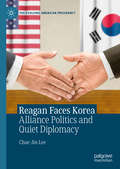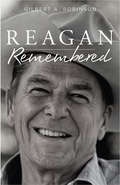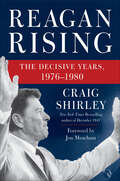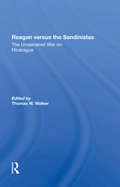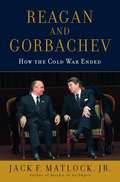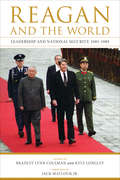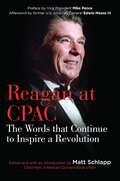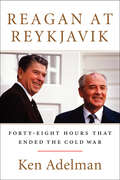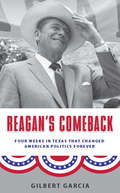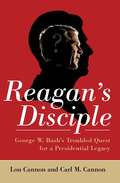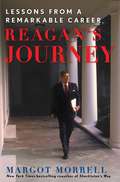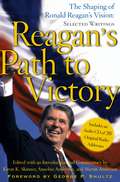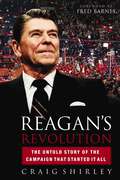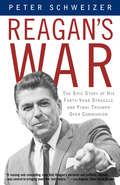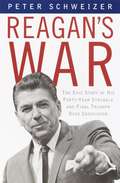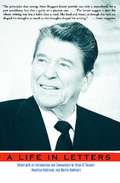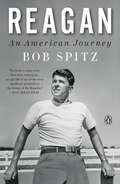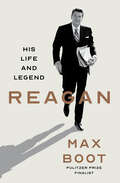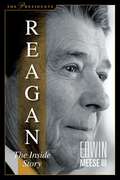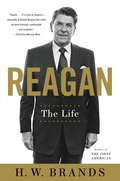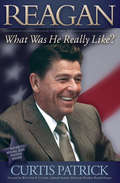- Table View
- List View
Reagan Faces Korea: Alliance Politics and Quiet Diplomacy (The Evolving American Presidency)
by Chae-Jin LeeThis is a unique and definitive study to reassess the complex dynamics of US-Korea diplomatic relations during the Reagan presidency. It examines the goals, methods, and legacy of Reagan’s policy toward Korea with emphasis on the realities of alliance politics and the tactics of quiet diplomacy. It questions a widely held view that Reagan showed simplistic, inattentive, and rigid approaches toward foreign affairs, arguing that his actual policy, as demonstrated in the Korea case, was more sophisticated, nuanced, and pragmatic than commonly assumed. Based on a vast amount of confidential diplomatic documents, especially in Korean, and interviews the author has conducted with US and Korean leaders, Lee sheds new light on Reagan's role in promoting democratization in South Korea as well as his engagement with North Korea.
Reagan Remembered
by Gilbert RobinsonFor the first time in presidential history, the major appointees of a president have come together to share stories and memories of their president, Ronald Reagan. These are never-before-told personal anecdotes from 81 of President Reagan's appointees.Former President George H.W. Bush, Colin Powell, Elizabeth Dole, Steve Forbes, James Baker, and Edwin Meese discuss their relationship with the 40th President of the United States. Democrats and Republicans can agree that Ronald Reagan possessed remarkable humor, courtesy, and consideration for others, natural charm, and a great sense of humor while displaying the toughness that brought an end to the Cold War with the Soviet Union.
Reagan Rising: The Decisive Years, 1976–1980
by Craig ShirleyNew York Times-Bestselling Author: This account of Ronald Reagan’s political comeback—and rescue of the GOP—is “an engrossing, richly detailed saga” (Booklist).Includes a foreword by Pulitzer Prize winner Jon MeachamCharting Ronald Reagan’s astonishing rise from the ashes of his 1976 presidential bid to overwhelming victory in 1980, Reagan Rising shows how American conservatism—and the nation itself—would never be the same.In 1976, when Reagan lost his second bid for the GOP presidential nomination (the first was in 1968), most observers believed his political career was over. Yet one year later, at the annual Conservative Political Action Conference, Reagan sounded like a new man. He introduced conservatives to a “New Republican Party”—one that looked beyond the traditional country club and corporate boardroom base to embrace “the man and woman in the factories . . . the farmer . . . the cop on the beat. Our party,” Reagan said, “must be the party of the individual. It must not sell out the individual to cater to the group.”Reagan’s movement quickly spread, championed by emerging conservative leaders and influential think tanks. Meanwhile, for the first time in modern history, Reagan also began drawing young people to American conservatism.But it was not only the former governor’s political philosophy that was changing. A new man was emerging as well: The angry anticommunist was evolving into a more reflective, hopeful, and spiritual leader. Championing the individual at home, rejecting containment and détente abroad, and advocating for the defeat of Soviet communism, his appeal crossed party lines.At a time when conservatives are seeking to redefine their identity in light of the Donald Trump phenomenon, Reagan Rising offers insight into the development of Reagan’s optimistic and unifying philosophy, and offers lessons for both established Republican leaders and emerging hopefuls.“Chronicles the Republicans’ emergence from the wilderness . . . [The author] is a sure-footed and entertaining observer of the hurly-burly of national politics.” —The New York Times“An insightful, thoughtful history that reminds us of the renewal that occurred the last time the Republican Party was near collapse. It is the story of the lifeguard Reagan rescuing a drowning party. If only . . . ” —Landon Parvin, former White House speechwriter for Ronald Reagan
Reagan Versus The Sandinistas: The Undeclared War On Nicaragua
by Thomas W Walker Peter Kornbluh Harvey Williams Eva GoldThe product of research and investigation by a team of sixteen authors, Reagan versus the Sandinistas is the most comprehensive and current study to date of the Reagan administration's mounting campaign to reverse the Sandinista revolution. The authors thoroughly examine all major aspects of Reagan's "low-intensity war," from the U.S. government's attempts at economic destabilization to direct CIA sabotage and the sponsorship of the contras or freedom fighters. They also explore less-public tactics such as electronic penetration, behind-the-scenes manipulation of religious and ethnic tensions, and harassment of U.S. Nicaraguan specialists and "fellow travelers." The book concludes with a consideration of the impact of these activities and their implications for international law, U.S. interests, U.S. polity, and Nicaragua itself. Reagan versus the Sandinistas is designed not only for courses on Latin America, U.S. foreign policy, and international relations, but also for students, scholars, and others interested in understanding one of the most massive, complex efforts—short of direct intervention—organized by the United States to overthrow the government of another country.
Reagan and Gorbachev: How the Cold War Ended
by Jack Matlock&“[Matlock&’s] account of Reagan&’s achievement as the nation&’s diplomat in chief is a public service.&”—The New York Times Book Review &“Engrossing . . . authoritative . . . a detailed and reliable narrative that future historians will be able to draw on to illuminate one of the most dramatic periods in modern history.&”—Los Angeles Times Book ReviewIn Reagan and Gorbachev, Jack F. Matlock, Jr., a former U.S. ambassador to the U.S.S.R. and principal adviser to Ronald Reagan on Soviet and European affairs, gives an eyewitness account of how the Cold War ended. Working from his own papers, recent interviews with major figures, and unparalleled access to the best and latest sources, Matlock offers an insider&’s perspective on a diplomatic campaign far more sophisticated than previously thought, waged by two leaders of surpassing vision. Matlock details how Reagan privately pursued improved U.S.-U.S.S.R. relations even while engaging in public saber rattling. When Gorbachev assumed leadership, however, Reagan and his advisers found a willing partner in peace. Matlock shows how both leaders took risks that yielded great rewards and offers unprecedented insight into the often cordial working relationship between Reagan and Gorbachev. Both epic and intimate, Reagan and Gorbachev will be the standard reference on the end of the Cold War, a work that is critical to our understanding of the present and the past.
Reagan and Pinochet
by Morris Morley Chris McgillionThis book is the first comprehensive study of the Reagan administration's policy toward the military dictatorship of General Augusto Pinochet in Chile. Based on new primary and archival materials, as well as on original interviews with former U. S. and Chilean officials, it traces the evolution of Reagan policy from an initial "close embrace" of the junta to a reevaluation of whether Pinochet was a risk to long-term U. S. interests in Chile and, finally, to an acceptance in Washington of the need to push for a return to democracy. It provides fresh insights into the bureaucratic conflicts that were a key part of the Reagan decision-making process and reveals not only the successes but also the limits of U. S. influence on Pinochet's regime - centered around the challenge of creating a viable civilian alternative that was acceptable to both the junta and Washington. Finally, it contributes to the ongoing debate about the U. S. approach toward democracy promotion in the Third World over the past half century.
Reagan and the World: Leadership and National Security, 1981--1989 (Studies in Conflict, Diplomacy, and Peace)
by Bradley Lynn ColemanEssays on a presidency during a pivotal period in international affairs, informed by newly declassified documents. Throughout his presidency, Ronald Reagan sought &“peace through strength&” during an era of historic change. In the decades since, pundits and scholars have argued over the president&’s legacy: Some consider Reagan a charismatic and consummate leader who renewed American strength and defeated communism; to others he was an ambitious and dangerous warmonger whose presidency was plagued with mismanagement, misconduct, and foreign policy failures. The recent declassification of Reagan administration records and the availability of new Soviet documents has created an opportunity for more nuanced, complex, and compelling analyses of this pivotal period in international affairs. In Reagan and the World, leading scholars and national security professionals offer fresh interpretations of the fortieth president's influence on American foreign policy. This collection addresses Reagan's management of the US national security establishment as well as the influence of Secretary of Defense Caspar Weinberger and others in the administration and Congress. The contributors present in-depth explorations of US-Soviet relations and American policy toward Asia, Latin America, Europe, and the Middle East. This balanced and sophisticated examination reveals the complexity of Reagan's foreign policy, clarifies the importance of other international actors of the period, and provides new perspectives on the final decade of the Cold War. &“Filled with lessons for current and future leaders . . . help[s] us understand how the past shapes the world today, including the intricate US relationship with Russia.&” ―Admiral James G. Stavridis, U.S. Navy (ret.), former Supreme Allied Commander, NATO
Reagan at CPAC: The Words that Continue to Inspire a Revolution
by Ronald ReaganContributors include Ben Shapiro, Senator Ted Cruz, U.S. Congressman Mark Meadows, Allie Beth Stuckey, Charlie Kirk, Katie Pavlich, Michael Reagan, KT McFarland, Dan Schneider, and Wayne LaPierre. Preface by Vice President Mike Pence. Ronald Reagan's wisdom is more relevant today than ever—and so are the speeches he gave at the Conservative Political Action Conference, collected here in one volume for the first time. Reagan’s wit, passion, and insight are on full display in these addresses that roused the conservative movement when it was embattled—and that celebrated its successes when Reagan led conservatives to political victory and the White House. In Reagan at CPAC, the former president's speeches are accompanied by commentaries from an all-star cast of conservative contributors who put Reagan's words in context while showcasing the remarkable relevance of Reagan's insights to the challenges we face today. Edited and introduced by Matt Schlapp, the chairman of the American Conservative Union, and with an afterword by Reagan’s former Counselor and Attorney General Edwin Meese III, Reagan at CPAC is an invaluable addition to any conservative’s bookshelf.
Reagan at Reykjavik: Forty-Eight Hours That Ended the Cold War
by Ken AdelmanA dramatic account of the Cold War’s turning point, the 1986 Reagan-Gorbachev summit in Iceland, by a key player in that weekend’s world-changing events.In October 1986, Ronald Reagan and Mikhail Gorbachev met for a forty-eight-hour summit in Reykjavik, Iceland. Planned as a short gathering to outline future talks, the meeting quickly turned to major international issues, including the Strategic Defensive Initiative (“Star Wars”) and the possibility of eliminating all nuclear weapons. Both men were at the height of their powers, and they had a rare opportunity to move toward peace. The meeting led to negotiations and concessions that neither side had predicted—and laid the groundwork for the most sweeping arms accord in history, adopted the following year, and the end of the Soviet Union a half decade later.From his position as a participant in these historic events, Ken Adelman, Regan’s arms control director, is able to reveal the motivations, relationships, and conversations that led to the summit’s breakthroughs. His analysis as both a participant and historian provides an invaluable perspective on this uniquely significant episode.Scrupulously researched and based on now-declassified documents, Reagan at Reykjavik tells the gripping tale of the weekend that changed the world. Adelman provides an honest, laser-etched portrait of President Reagan at one of his finest and most challenging moments—and, indisputably, one of the most significant triumphs of his presidency.
Reagan's America: Innocents at Home
by Garry WillsNew York Times Bestseller: A &“remarkable and evenhanded study of Ronald Reagan&” from the Pulitzer Prize–winning author of Lincoln at Gettysburg (The New York Times). Updated with a new preface by the author, this captivating biography of America&’s fortieth president recounts Ronald Reagan&’s life—from his poverty-stricken Illinois childhood to his acting career to his California governorship to his role as commander in chief—and examines the powerful myths surrounding him, many of which he created himself. Praised by some for his sunny optimism and old-fashioned rugged individualism, derided by others for being a politician out of touch with reality, Reagan was both a popular and polarizing figure in the 1980s United States, and continues to fascinate us as a symbol. In Reagan&’s America, Garry Wills reveals the realities behind Reagan&’s own descriptions of his idyllic boyhood, as well as the story behind his leadership of the Screen Actors Guild, the role religion played in his thinking, and the facts of his military service. With a wide-ranging and balanced assessment of both the personal and political life of this outsize American icon, the author of such acclaimed works as What Jesus Meant and The Kennedy Imprisonment &“elegantly dissects the first U.S. President to come out of Hollywood&’s dream factory [in] a fascinating biography whose impact is enhanced by techniques of psychological profile and social history&” (Los Angeles Times).
Reagan's Comeback
by Gilbert GarciaNever before has the story been told of the dramatic turning point when Ronald Reagan found his voice as a presidential contender and overcame the Republican establishment. Reagan's Comeback is the story of how one state, one man, and one month changed national politics forever. Chronicling how Reagan's political career nearly ended, this turnabout story is told by those who made it happen: campaign volunteers, financiers, political activists, and media observers. Positioning Reagan to win in 1980, the birth of the "Reagan Democrat" transformed Texas from Democratic stronghold to the reliably Republican powerhouse it is today, since producing five Republican presidential candidates and two Republican presidents, with more to follow. Reagan's rise and victory against Ford in 1976 mirrors the current climate between the Tea Party movement and the GOP. With the 2012 election in sight, there is no better time to finally tell the whole story of how the Reagan Revolution found its launching point.
Reagan's Comeback
by Gilbert GarciaNever before has the story been told of the dramatic turning point when Ronald Reagan found his voice as a presidential contender and overcame the Republican establishment. Reagan's Comeback is the story of how one state, one man, and one month changed national politics forever. Chronicling how Reagan's political career nearly ended, this turnabout story is told by those who made it happen: campaign volunteers, financiers, political activists, and media observers. Positioning Reagan to win in 1980, the birth of the "Reagan Democrat" transformed Texas from Democratic stronghold to the reliably Republican powerhouse it is today, since producing five Republican presidential candidates and two Republican presidents, with more to follow. Reagan's rise and victory against Ford in 1976 mirrors the current climate between the Tea Party movement and the GOP. With the 2012 election in sight, there is no better time to finally tell the whole story of how the Reagan Revolution found its launching point.
Reagan's Disciple: George W. Bush's Troubled Quest for a Presidential Legacy
by Carl M. Cannon Lou CannonAn insightful examination of what remains of the Reagan agenda in the Bush era by a father/son reporting team that has covered six of the last seven presidencies
Reagan's Journey
by Margot MorrellA RENOWNED LEADERSHIP EXPERT EXAMINES THE LIFE OF R ONALD REAGAN, EXTRACTING THE KEY C OMPONENTS OF HIS IMMENSE S UCCESS--PERSONAL AND PROFESSIONAL--AND OFFERS AN ILLUMINATING MODEL F OR LEADERS AND MANAGERS IN EVERY WALK OF LIFE. Since leaving office, Ronald Reagan has emerged as among America's greatest-- and best-loved--leaders. Today he is known as "the Great Communicator," but in the course of his sixty-year career, Reagan faced obstacles and hardships that could have stalled him at any point along the way. After every disaster, he picked himself up and kept moving forward. How did he manage his career and handle the hurdles involved in transitioning from actor and union official into a public speaker in high demand and from there into an extraordinarily successful politician? What can we learn from the way the perennial "new kid in town" muscled through adversities, maintained his focus, stayed true to his principles, and achieved his goals? In a compelling narrative that is both a motivational leadership teaching tool and a fascinating biography, bestselling author Margot Morrell sheds light on the challenges and heartbreaks that shaped Ronald Reagan. Four times his life slammed into a brick wall: his 1948 divorce from actress Jane Wyman; the termination of his long-standing contract with Warner Bros.; the end of his eight-year association with General Electric; and a hard-fought loss to President Gerald Ford in the 1976 primary campaign. Setting politics and policies largely aside, Morrell highlights the strategies and tactics Ronald Reagan used to transform himself from shy introvert to confident communicator; the methods and tools he employed to keep his career on track; and the skills he developed that led to his many accomplishments. Each chapter of Reagan's Journey is followed by summary bullet points and an essential overview titled "Working It In," to facilitate these lessons into your formation as a leader. Anyone interested in strengthening their leadership and communications skills, becoming more resilient in the face of setbacks, or taking their careers to the next level will find practical and useful lessons in the life of Ronald Reagan.
Reagan's Legacy in a World Transformed
by Jeffrey L. ChidesterReagan's Legacy in a World Transformed offers a timely retrospective on the fortieth president's policies and impact on today's world, from the influence of free market ideas on economic globalization, to the role of an assertive military in U.S. foreign policy, to reduction of nuclear arsenals in the interest of stability.
Reagan's Path to Victory
by Martin Anderson Annelise Anderson Kiron K. Skinner George P. ShultzIn the last years of Ronald Reagan's life, his voluminous writings on politics, policy, and people finally emerged and offered a Rosetta stone by which to understand him. From 1975 to 1979, in particular, he delivered more than 1,000 radio addresses, of which he wrote at least 680 himself. When drafts of his addresses were first discovered, and a selection was published in 2001 as Reagan, In His Own Hand by the editors of this book, they caused a sensation by revealing Reagan as a prolific and thoughtful writer, who covered a wide variety of topics and worked out the agenda that would drive his presidency. What was missed in that thematic collection, however, was the development of his ideas over time. Now, in Reagan's Path to Victory, a chronological selection of more than 300 addresses with historical context supplied by the editors, readers can see how Reagan reacted to the events that defined the Carter years and how he honed his message in the crucial years before his campaign officially began. The late 1970s were tumultuous times. In the aftermath of Vietnam and Watergate, America's foreign and domestic policies were up for grabs. Reagan argued against the Panama Canal treaties, in vain; against the prevailing view that the Vietnam War was an ignoble enterprise from the start; against détente with the Soviet Union; against the growth of regulation; and against the tax burden. Yet he was fundamentally an optimist, who presented positive, values-based prescriptions for the economy and for Soviet relations. He told many inspiring stories; he applauded charities and small businesses that worked to overcome challenges. As Reagan's Path to Victory unfolds, Reagan's essays reveal a presidential candidate who knew himself and knew his positions, who presented a stark alternative to an incumbent administration, and who knew how to reach out and touch voters directly. Reagan's Path to Victory is nothing less than a president's campaign playbook, in his own words.
Reagan's Revolution: The Untold Story of the Campaign That Started It All
by Craig ShirleyToday's political scene looks nothing like it did thirty years ago, and that is due mostly to Reagan's monumental reshaping of the Republican party. What few people realize, however, is that Reagan's revolution did not begin when he took office in 1980, but in his failed presidential challenge to Gerald Ford in 1975-1976. This is the remarkable story of that historic campaign-one that, as Reagan put it, turned a party of "pale pastels" into a national party of "bold colors." Featuring interviews with a myriad of politicos, journalists, insiders, and observers, Craig Shirley relays intriguing, never-before-told anecdotes about Reagan, his staff, the campaign, the media, and the national parties and shows how Reagan, instead of following the lead of the ever-weakening Republican party, brought the party to him and almost single-handedly revived it.
Reagan's War
by Peter SchweizerReagan's War is the story of Ronald Reagan's personal and political journey as an anti-communist, from his early days as an actor to his years in the White House. Challenging popular misconceptions of Reagan as an empty suit who played only a passive role in the demise of the Soviet Union, Peter Schweizer details Reagan's decades-long battle against communism.Bringing to light previously secret information obtained from archives in the United States, Germany, Poland, Hungary, and Russia--including Reagan's KGB file--Schweizer offers a compelling case that Reagan personally mapped out and directed his war against communism, often disagreeing with experts and advisers. An essential book for understanding the Cold War, Reagan's War should be read by open-minded readers across the political spectrum.From the Trade Paperback edition.the USSR drew the attention of Soviet officials, who began a KGB file on him when he was still governor of California. By the time he was elected president, they viewed him as a serious threat to their interests. Reagan's War shows just how right they were, presenting compelling evidence that Reagan personally mapped out and directed a campaign to bankrupt the Soviet Union and wage an economic and political war against Moscow.In telling the story of Reagan's ultimate triumph, Schweizer also brings to light dozens of previously unknown facts about the Cold War, based on secret documents obtained from archives in Russia, Germany, Poland, Hungary, and the United States. Among his many startling revelations are Kissinger's private deals with Soviet leaders that protected his own political viability while allowing the Soviets to pursue their goals within their own sphere; a North Korean and East German plot to assassinate Reagan in 1983; Reagan's secret funding of Solidarity in Poland; and the behind-the-scenes support Soviets and East Germans provided for European and American peace movements, as well as their clandestine contacts with U.S. government officials.A fresh, often startling look at Ronald Reagan and his central role in winning the war for global dominance in the 1980s, Reagan's War is a major work of twentieth-century history.From the Hardcover edition.
Reagan's War: The Epic Story of His Forty Year Struggle and Final Triumph Over Communism
by Peter SchweizerRonald Reagan has been considered at best an amiable dunce, a genial actor who simply mouthed whatever slogans his right-wing puppetmasters put in front of him. This book presents Reagan as President and statesman. Reagan's War is the story of Ronald Reagan's personal and political journey, beginning with his days in Hollywood, where he led the movie industry's resistance to an attempted communist takeover of Hollywood unions. The fight against communism changed the whole direction of his life. Schweizer chronicles Reagan's anti-communist crusade from governor of California to the White House. Along the way, Reagan moved from an initial posture of containment to being an advocate of head-on confrontation. Schweizer brings to light dozens of previously unknown facts about the Cold War, based on secret documents obtained from archives in Russia, Germany, Poland, Hungary, and the United States. Among his revelations are a North Korean and East German plot to assassinate Reagan in 1983; Reagan's secret funding of Solidarity of Poland; and the behind-the-scenes support that the Soviets and East Germans provided for European and American peace movements, as well as their clandestine contacts with U.S. government officials.
Reagan: A Life in Letters
by Martin Anderson Annelise Anderson Kiron K. SkinnerRonald Reagan may have been the most prolific correspondent of any American president since Thomas Jefferson. The total number of letters written over his lifetime probably exceeds 10,000. Their breadth is equally astonishing -- with friends and family, with politicians, children, and other private citizens, Reagan was as dazzling a communicator in letters as he was in person. Collectively, his letters reveal his character and thinking like no other source. He made candid, considerate, and tough statements that he rarely made in a public speech or open forum. He enjoyed responding to citizens, and comforting or giving advice or encouragement to friends. Now, the most astonishing of his writings, culled in Reagan: A Portrait in Letters, finally and fully reveal the true Ronald Reagan. Many of Reagan's handwritten letters are among the most thoughtful, charming, and moving documents he produced. Long letters to his daughter Patti, applauding her honesty, and son Ron Jr., urging him to be the best student he can be, reveal Reagan as a caring parent. Long-running correspondence with old friends, carried on for many decades, reveals the importance of his hometown and college networks. Heartfelt advice on love and marriage, fond memories of famous friends from Hollywood, and rare letters about his early career allow Reagan to tell his own full biography as never before. Running correspondence with young African-American student Ruddy Hines reveals a little-known presidential pen pal. The editors also reveal that another long-running pen-pal relationship, with fan club leader Lorraine Wagner, was initially ghostwritten by his mother, until Reagan began to write to Wagner himself some years later. Reagan's letters are a political and historical treasure trove. Revealed here for the first time is a running correspondence with Richard Nixon, begun in 1959 and continuing until shortly before Nixon's death. Letters to key supporters reveal that Reagan was thinking of the presidency from the mid-1960s; that missile defense was of interest to him as early as the 1970s; and that few details of his campaigns or policies escaped his notice. Dozens of letters to constituents reveal Reagan to have been most comfortable and natural with pen in hand, a man who reached out to friend and foe alike throughout his life. Reagan: A Life in Letters is as important as it is astonishing and moving.
Reagan: An American Journey
by Bob SpitzFrom New York Times bestselling biographer Bob Spitz, a full and rich biography of an epic American life, capturing what made Ronald Reagan both so beloved and so transformational. <P><P>More than five years in the making, based on hundreds of interviews and access to previously unavailable documents, and infused with irresistible storytelling charm, Bob Spitz's REAGAN stands fair to be the first truly post-partisan biography of our 40th President, and thus a balm for our own bitterly divided times. <P><P>It is the quintessential American triumph, brought to life with cinematic vividness: a young man is born into poverty and raised in a series of flyspeck towns in the Midwest by a pious mother and a reckless, alcoholic, largely absent father. <P><P>Severely near-sighted, the boy lives in his own world, a world of the popular books of the day, and finds his first brush with popularity, even fame, as a young lifeguard. Thanks to his first great love, he imagines a way out, and makes the extraordinary leap to go to college, a modest school by national standards, but an audacious presumption in the context of his family's station. From there, the path is only very dimly lit, but it leads him, thanks to his great charm and greater luck, to a solid career as a radio sportscaster, and then, astonishingly, fatefully, to Hollywood. And the rest, as they say, is history. <P><P>Bob Spitz's REAGAN is an absorbing, richly detailed, even revelatory chronicle of the full arc of Ronald Reagan's epic life - giving full weight to the Hollywood years, his transition to politics and rocky but ultimately successful run as California governor, and ultimately, of course, his iconic presidency, filled with storm and stress but climaxing with his peace talks with the Soviet Union that would serve as his greatest legacy. It is filled with fresh assessments and shrewd judgments, and doesn't flinch from a full reckoning with the man's strengths and limitations. <P><P>This is no hagiography: Reagan was never a brilliant student, of anything, and his disinterest in hard-nosed political scheming, while admirable, meant that this side of things was left to the other people in his orbit, not least his wife Nancy; sometimes this delegation could lead to chaos, and worse. <P><P>But what emerges as a powerful signal through all the noise is an honest inherent sweetness, a gentleness of nature and willingness to see the good in people and in this country, that proved to be a tonic for America in his time, and still is in ours. It was famously said that FDR had a first-rate disposition and a second-rate intellect. <P><P>Perhaps it is no accident that only FDR had as high a public approval rating leaving office as Reagan did, or that in the years since Reagan has been closing in on FDR on rankings of Presidential greatness. <P><P>Written with love and irony, which in a great biography is arguably the same thing, Bob Spitz's masterpiece will give no comfort to partisans at either extreme; for the rest of us, it is cause for celebration.
Reagan: His Life and Legend
by Max BootSon of the Midwest, movie star, and mesmerizing politician—America’s fortieth president comes to three-dimensional life in this gripping and profoundly revisionist biography. <P><P> In this “monumental and impressive” biography, Max Boot, the distinguished political columnist, illuminates the untold story of Ronald Reagan, revealing the man behind the mythology. Drawing on interviews with over one hundred of the fortieth president’s aides, friends, and family members, as well as thousands of newly available documents, Boot provides “the best biography of Ronald Reagan to date” (Robert Mann). <P><P> The story begins not in star-studded Hollywood but in the cradle of the Midwest, small-town Illinois, where Reagan was born in 1911 to Nelle Clyde Wilson, a devoted Disciples of Christ believer, and Jack Reagan, a struggling, alcoholic salesman. Boot vividly creates a portrait of a handsome young man, indeed a much-vaunted lifeguard, whose early successes mirrored those of Horatio Alger. And contextualizing Reagan’s life against American history, Boot re-creates the world in which Reagan transitioned from local Iowa sportscaster to budding screen actor. <P><P> The world of Hollywood from the 1930s to the 1950s would prove significant, not only in Reagan’s coming-of-age in such classics as Knute Rockne and Kings Row but during the twilight of his film career, when he played opposite a chimpanzee in Bedtime for Bonzo, and then his eventual emergence as a television host of General Electric Theater, which established his bona fides as one of the leading conservative voices of the time. Indeed, the leap to California governor in 1966 seemed almost preordained, in which Reagan became a bellwether for a nation in the throes of a generational shift. <P><P> Reagan’s 1980 presidential election augured a shift that continues into this century. Boot writes not as a partisan but as a historian seeking to set the story straight. He explains how Reagan was an ideologue but also a supreme pragmatist who signed pro-abortion and gun control bills as governor, cut deals with Democrats in both Sacramento and Washington, and befriended Mikhail Gorbachev to end the Cold War. A master communicator, Reagan revived America’s spirits after the traumas of Vietnam and Watergate. But Boot also shows how Reagan was armored in obliviousness. He traces Reagan’s opposition to civil rights over forty years, reveals how he neglected the exploding AIDS epidemic, and details how America experienced a level of income inequality not seen since the Gilded Age. <P><P> With its revelatory insights, Reagan: His Life and Legend is no apologia, depicting a man with a good-versus-evil worldview derived from his moralistic upbringing and Hollywood westerns. Providing fresh examinations of “trickle-down economics,” the Cold War’s end, the Iran-Contra affair, as well as a nuanced portrait of Reagan’s family, this definitive biography is as compelling a presidential biography as any in recent decades. <p> <b>New York Times Bestseller</b>
Reagan: The Inside Story (The Presidents)
by Edwin Meese IIIFormer attorney general Edwin Meese III offers unequaled insight on the career and policies of his friend and former boss, Ronald Reagan. <P><P> From Reagan's days as governor of California to his two terms in the White House, Meese was his highest-ranking political confidant—the official closest to Reagan not only through length of service but also through mutual comprehension of the problems that concerned the nation. <P><P>Meese tells the Reagan story as it happened, refuting many common misconceptions about America's fortieth chief executive and providing new revelations about the Iran-Contra affair, the so-called Boland amendments, and more.
Reagan: The Life
by H. W. BrandsFrom the two-time Pulitzer Prize finalist, bestselling historian, and author of Our First Civil War—and "the rare academic historian who can write like a bestselling novelist" (USA Today)—comes an irresistible portrait of an underestimated politician whose pragmatic leadership and steadfast vision transformed the nation.In his magisterial new biography, H. W. Brands brilliantly establishes Ronald Reagan as one of the two great presidents of the twentieth century, a true peer to Franklin Roosevelt. Reagan conveys with sweep and vigor how the confident force of Reagan&’s personality and the unwavering nature of his beliefs enabled him to engineer a conservative revolution in American politics and play a crucial role in ending communism in the Soviet Union. Reagan shut down the age of liberalism, Brands shows, and ushered in the age of Reagan, whose defining principles are still powerfully felt today.Employing archival sources not available to previous biographers and drawing on dozens of interviews with surviving members of Reagan&’s administration, Brands has crafted a richly detailed and fascinating narrative of the presidential years. He offers new insights into Reagan&’s remote management style and fractious West Wing staff, his deft handling of public sentiment to transform the tax code, and his deeply misunderstood relationship with Soviet leader Mikhail Gorbachev, on which nothing less than the fate of the world turned. Look for H.W. Brands's other biographies: THE FIRST AMERICAN (Benjamin Franklin), ANDREW JACKSON, THE MAN WHO SAVED THE UNION (Ulysses S. Grant), and TRAITOR TO HIS CLASS (Franklin Roosevelt).
Reagan: Volume 2 (Reagan: What Was He Really Like? #2)
by Curtis PatrickBehind-the-scenes anecdotes and first-person recollections from forty-nine diverse people illuminate their personal relationships with Ronald Reagan. What was Ronald Reagan like in private? How did he treat his children? How did he handle pressure? This collection of intimate remembrances of the late President&’s staffers, colleagues, and friends sheds new light on the life and career of the immortal &“Gipper.&” See how Reagan used humor to disarm his most ardent critics and tenacious opponents. Marvel at his gift for persuading difficult, almost impossible to deal with legislators. Learn the untold story behind the secret plan hatched by former Air Force Secretary Thomas C. Reed and a handful of dedicated insiders to launch Reagan&’s first campaign for president of the United States in 1968. Many of author Curtis Patrick&’s interview subjects were members of Reagan&’s original 1966 campaign for governor of California. Some came aboard soon after the election and were appointed to fill key positions in the governor&’s cabinet and to head up state agencies and departments. For the most part, except in a few cases, these interviewees had never been recorded or published before. &“Curtis, I not only like your book; I love it!&” —Edwin Meese III, former US attorney general
